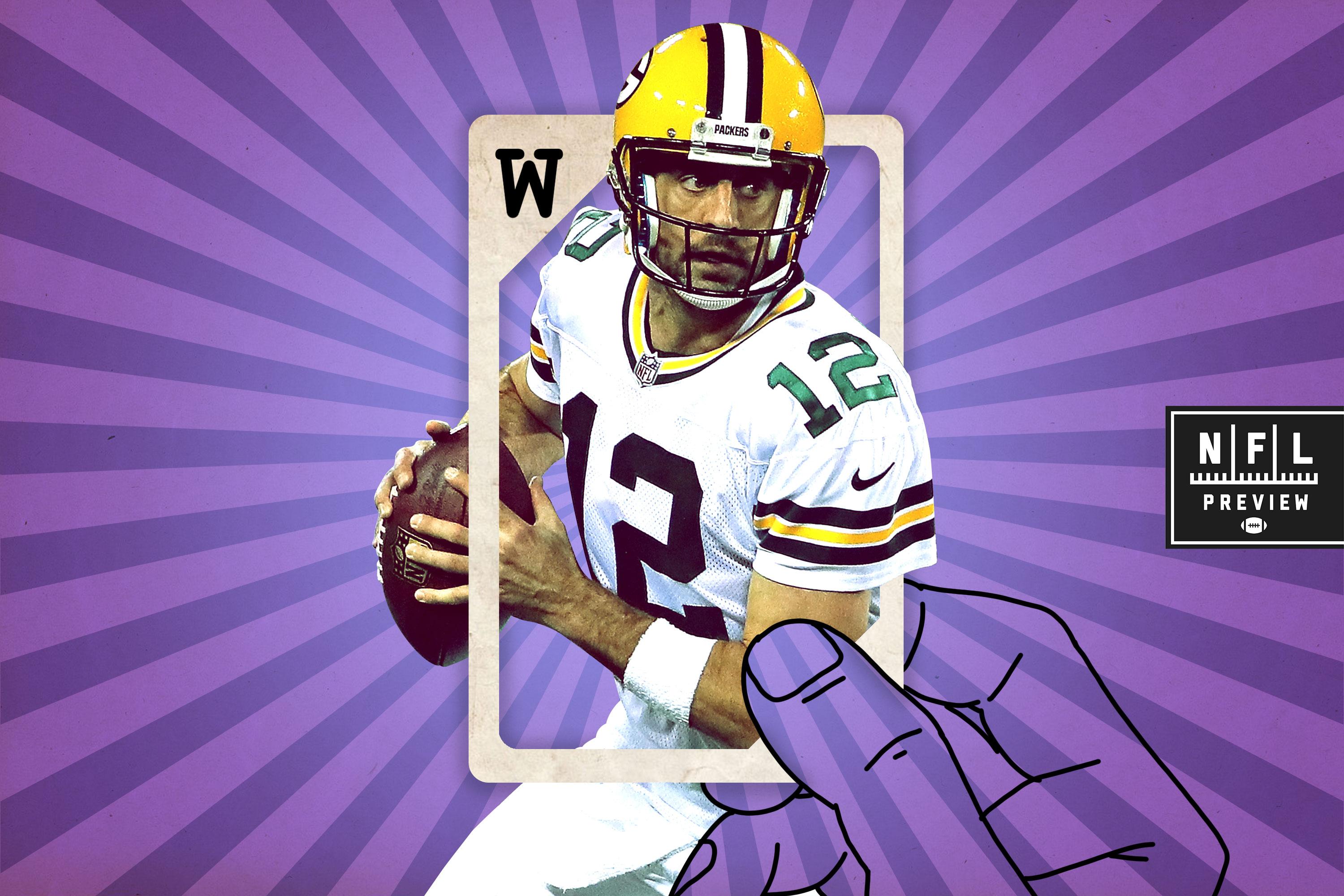
Fantasy football is won and lost by players who wildly outperform—or underperform—expectations. Roll the dice on the right player, and you’ll cruise through your league (hello there, Todd Gurley owners!). But put too much stock in a guy who busts, and it’ll be a long wait until next year’s draft (Isaiah Crowell owners: I’m sorry). Welcome to Fantasy Wild Cards, where we’ll examine the players with the biggest boom-or-bust prospects for the upcoming season. Will these players make your fantasy season, or break it?
Wait to draft a quarterback. That’s one of the most universal bits of fantasy advice handed out each year. Even though quarterback is the single-most impactful position in all of sports, in fantasy football, passers take a backseat to running backs and wide receivers in the early rounds of the draft. That’s because the position is deep, and, unless you’re in a two-QB league, owners need to start only one each week. So while rubes may be enticed to take a quarterback earlier, fantasy experts know to wait.
Yet Aaron Rodgers may be an exception to that rule this season. The Packers quarterback has been dominant—both in real life and fantasy—throughout his professional career. Since he grabbed the Green Bay starting job in 2008, no passer has put up more fantasy points per game—he’s beaten out legends like Peyton Manning and Tom Brady, world-burners like Drew Brees, and dual-threat quarterbacks like Cam Newton, who pick up more points via their legs. And that’s even including his numbers from 2008, when he was in his first season as a starter, and a couple of games (like Week 6 in 2017 and Week 9 in 2013) in which Rodgers got injured early and accumulated almost no stats. His 2011 season is the best fantasy year of all time for a QB on a per-game basis, and his career average of 20.25 fantasy points per game is also tops for a passer in NFL history.
Rodgers is so much better than his peers that he’s the one quarterback that you shouldn’t treat like … a quarterback.
In broad strokes, the rationale behind the “wait to take a QB” strategy is that the difference between a top running back or wide receiver and an average player at those positions is far greater than the same difference among quarterbacks. And since teams in most leagues start two RBs and two WRs—in addition to one or multiple flex positions—and only one quarterback, there are generally something like 30 starting running backs and 30 wide receivers each week compared to just 12 starting passers. Last season, Todd Gurley scored 21.3 fantasy points per game—over 13 points per game more than the 30th-highest scoring RB, Jerick McKinnon. Antonio Brown (14.95 points per game) hauled in seven points more per game than the 30th-best receiver, Cooper Kupp. But Russell Wilson—the highest-scoring QB last year—put up a 21.7 average, which was just five points per game more than the 12th-highest passer.
Those numbers don’t shift much when considered over longer timelines, either. In the past four seasons combined, the top fantasy running back in points per game (Ezekiel Elliott) is more than nine points above the 30th-best running back; the top wide receiver (Brown) is more than six points ahead of the 30th-ranked wideout; and the top quarterback (Rodgers) is only four points ahead of the 12th-ranked passer. (As for tight ends, Rob Gronkowski has five points more per game than the 12th-best tight end, though he may be an even bigger anomaly than Rodgers.)
Comparing players to others at their position is the basic principle behind value-based drafting, or VBD, a concept popularized by Joe Bryant at Footballguys.com. Bryant believes the best way to value fantasy players isn’t to look at who scores the most points, but who scores more than a baseline-level peer at the same position. Pro Football Reference calculates its own version of VBD, and while I have some quibbles with its math (it’s unclear to me why it uses the 24th-best running back as the position’s baseline, but the 30th-best wide receiver), it’s a good rough estimate for how players across positions performed in a given year in fantasy. Here’s how Rodgers has done by VBD through his career:
2017: N/A (injured)
2016: 4th
2015: 52nd
2014: 12th
2013: N/A (injured)
2012: 9th
2011: 1st
2010: 17th
2009: 4th
2008: 11th
That’s a top-20 result in seven of the eight healthy seasons Rodgers has played. VBD is not infallible by any means, but these numbers clearly show that Rodgers is not just elite among quarterbacks but among all fantasy positions.
So if Rodgers is an elite fantasy player, regardless of position, when should he be drafted? He’s currently being taken around the 30th pick in 12-team, standard-scoring leagues, making him a mid-third-rounder. And while no one is suggesting you leave top running backs or wide receivers on the board and take Rodgers with the first overall pick, at what point in the draft does Rodgers leap ahead of the other remaining players and become the most valuable guy on the board?
The principles of VBD can offer some guidance. Rodgers’s average production from 2014 to 2017 was the best among QBs and had him scoring about four more points per game than the 12th-best fantasy passer. If we take that average difference and look at which running back scored at least four more points per game than the 30th-best rusher from 2014 to 2017, we get Arian Foster, who ranked eighth at his position in points per game in that span. To find that difference in receivers, you have to go even higher up the list, all the way to Julio Jones, who was the third-best receiver in points per game over those four years.
That’s seven running backs, two receivers, and one tight end (Gronk) who provide more value over a baseline-level player than Rodgers does over a baseline QB—but that doesn’t mean you should draft Rodgers 10th overall. There are a few wrinkles that VBD doesn’t account for. For one, far more than 30 running backs and wide receivers are drafted in most leagues—it’s not like you can pick up the 30th-best wideout on waivers when you need a replacement. And two, solid QBs are much easier to come by on a week-to-week basis should you need one.
But the heart of the argument against Rodgers is that he limits your team’s upside. Even if he far outscores the other players at his position, he’ll only be worth four, five, or six more points per game than your league’s worst starting quarterback. Meanwhile if you’re drafting running backs and wide receivers through the third or fourth rounds, there’s a chance you hit on a guy who becomes this year’s Gurley or Brown—players who could outscore the 30th-place player by double-digit points per game. Rodgers may raise your team’s floor, but he also could limit your ceiling.
On Rodgers’s side, however, is reliability. Discounting the games he lost to injury, Rodgers has been the fourth-most consistent quarterback in fantasy football over the past two seasons:
A set-it-and-forget-it player like Rodgers has considerable value by Pick 30, if not before then. Many of the running backs and wide receivers drafted in that range will turn out to be busts, but Rodgers, if healthy, will almost certainly be a top contributor. How long you wait on Rodgers in favor of more boom-or-bust-type players is essentially a referendum on how much you want to gamble on your fantasy season. And that’s much more of a feel thing than a math thing.
Of course, that assumes that Rodgers will have another great season. He broke his collarbone last season and returned to play just one game before Green Bay was eliminated from playoff contention. And remember 2015, that one weird down year in which he had a career-low 238.8 passing yards per game? That came when Jordy Nelson missed the season with an ACL injury. Nelson is now in Oakland, and there’s no replacing the legendary chemistry he and Rodgers had.
Luckily, though, Rodgers finally has a great option at tight end this season, and I think he’ll find a new best friend in Jimmy Graham. Part of what makes Rodgers such a great fantasy passer is that he racks up touchdowns, and Graham could be the perfect red zone machine for Green Bay:
Another change for Rodgers this offseason has been his seemingly increased sense of urgency. In early August, he criticized the Packers’ young receivers after a lethargic scout-team drill and then doubled down on his comments a few days later.
“I’m getting older and grumpier,” Rodgers said. “I’ve been at this for a long time. I’m tired, too; we’re all a little tired. When you get a little tired, the fuse gets a little shorter.”
I can’t recall an offseason where Rodgers was this frustrated. Maybe it’s that he’s turning 35 in December—the same age Brett Favre was in 2005 when the Packers drafted his eventual replacement—and he knows his Super Bowl window won’t remain open forever. Or maybe he’s not thinking that hard about his future, and it really is just about the young wideouts. But either way, Angry Aaron Rodgers is someone worth keeping an eye on.
Ultimately, the “wait on a QB” advice is solid—quarterbacks just aren’t as valuable overall as running backs and wideouts. But Rodgers’s whole career has been about breaking the norm—and he’s the only passer worth grabbing sooner rather than later.


